Class 9 - Mathematics
Herons Formula - Exercise 12.2
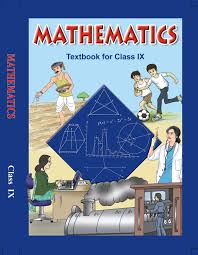
Top Block 1
Exercise 12.2
Question : 1: A park, in the shape of a quadrilateral ABCD, has ∠C = 90°, AB = 9 m, BC = 12 m, CD = 5 m and AD = 8 m. How much area does it occupy?
Answer :
ABCD is the park as shown in the figure.
Join BD.
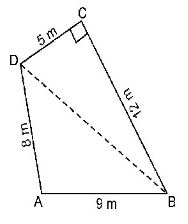
In ∆DBC, we have
DB2 = BC2 + CD2 [From Pythagoras theorem]
⇒ DB2 = (12)2 + 52
⇒ DB2 = 144 + 25 = 169
⇒ DB = √169
⇒ DB = 13
Area of ∆DBC = 1/2 * base * height
= 1/2 * 12 * 5
= 6 * 5
= 30 m2
In ∆ABD, a = 9 m, b = 8 m, c = 13 m
So, s = (a + b + c)/2 = (9 + 8 + 13)/2 = 30/2 = 15 m
Now, Area of the triangle ABD = √{s(s – a)(s – b)(s – c)}
= √{15(15 – 9)(15 – 8)(15 – 13)}
= √{15 * 6 * 7 * 2}
= √1260 = 35.5 m2 (approx.)
Now, area of the park = area of ∆DBC + area of ∆ABD
= (30 + 35.5) m2 = 65.5 m2
Question : 2: Find the area of a quadrilateral ABCD in which AB = 3 cm, BC = 4 cm, CD = 4 cm, DA = 5 cm and AC = 5 cm.
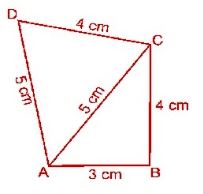
Mddle block 1
Answer :
In ∆ABC, we have
AB2 + BC2 = 9 + 16 = 25 = AC2
Hence, ABC is a right triangle, right angled at B
[By converse of Pythagoras theorem]
So, area of ∆ABC = 1/2 * base * height
= 1/2 * 3 * 4
= 3 * 2 = 6 cm2
In ∆ACD, a = 5 cm, b = 4 cm, c = 5 cm
s = (a + b + c) = (5 + 4 + 5)/2 = 14/2 = 7 cm
Now, Area of the triangle ACD = √{s(s – a)(s – b)(s – c)}
= √{7(7 – 5)(7 – 4)(7 – 5)}
= √{7 * 2 * 3 * 2}
= √84
= 9.2 cm2 (approx.)
So, area of the quadrilateral = area of ∆ABC + area of ∆ACD
= (6 + 9.2) cm2
= 15.2 cm2
Question : 3: Radha made a picture of an aeroplane with coloured paper as shown in the figure. Find the total area of the paper used.
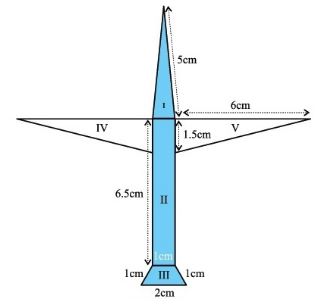
Answer :
For the triangle marked I:
a = 5 cm, b = 5 cm, c = 1 cm
s = (a + b + c) = (5 + 5 + 1)/2 = 11/2 = 5.5 cm
Now, Area of the triangle = √{s(s – a)(s – b)(s – c)}
= √{5.5(5.5 – 5)(5.5 – 5)(5.5 – 1)}
= √{5.5 * 0.5 * 0.5 * 4.5}
= √6.1875
= 2.5 cm2 (approx.)
For the rectangle marked II:
Length = 6.5 cm, Breadth = 1 cm
Area of the rectangle = 6.5 * 1 cm2 = 6.5 cm2
For the trapezium marked III:
Draw AF || DC and AE ⊥ BC
AD = FC = 1 cm, DC = AF = 1 cm
So, BF = BC – FC = (2 – 1) cm = 1 cm
Hence, ∆ABF is equilateral.
Also, E is the mid-point of BF.
Now, BE = 1/2 cm = 0.5 cm
Also, AB2 = AE2 + BE2 [Pythagoras theorem]
⇒ AE2 = 12 – (0.5)2
⇒ AE2 = 1 – 0.25
⇒ AE2 = 0.75
⇒ AE = √0.75
⇒ AE = 0.9 cm (approx.)
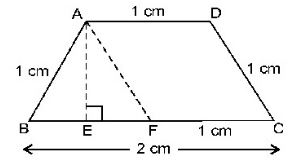
Area of the trapezium = 1/2 * (sum of the parallel sides) * distance between them.
= 1/2 * (BC + AD) * AE
= 1/2 * (2 + 1) * 0.9
= 1/2 * 3 * 0.9
= 2.7/2
= 1.4 cm2
For the triangle marked IV:
It is a right-triangle
∴ Area of the triangle = 1/2 * base * height
= 1/2 * 6 * 1.5
= 3 * 1.5
= 4.5 cm2
For the triangle marked V:
This triangle is congruent to the triangle marked IV.
Hence, area of the triangle = 4.5 cm2
Total area of the paper used = (2.5 + 6.5 + 1.4 + 4.5 + 4.5) cm2
= 19.4 cm2
Question : 4: A triangle and a parallelogram have the same base and the same area. If the sides of the triangle are 26 cm, 28 cm and 30 cm and the parallelogram stands on the base 28 cm, find the height of the parallelogram.
Answer :
In the figure, ABCD is a parallelogram and ABE is the triangle which stands on the base AB
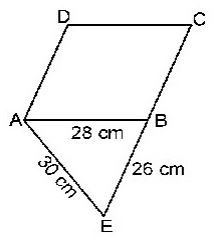
For the triangle ABE, a = 30 cm, b = 28 cm, c = 26 cm.
So, s = (a + b + c)/2 = (30 + 28 + 26)/2 = 84/2 = 42 cm
Now, area of the ∆ABE = √{s(s – a)(s – b)(s – c)}
= √{42(42 – 30)(42 – 28)(42 – 26)}
= √{42 * 12 * 14 * 16}
= √112896
= 336 cm2
Now, area of the parallelogram = base * height
⇒ 336 = 28 * Height [Given, area of the triangle = area of the parallelogram]
⇒ Height = 336/28
⇒ Height = 12
Hence, the height of the parallelogram = 12 cm
Question : 5: A rhombus shaped field has green grass for 18 cows to graze. If each side of the rhombus is 30 m and its longer diagonal is 48 m, how much area of grass field will each cow be getting?
Answer :
Clearly, the diagonal AC of the rhombus divides it into two congruent triangles.
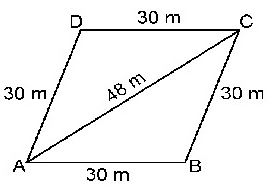
For triangle ABC, a = b = 30 m, c = 48 m.
So, s = (a + b + c)/2 = (30 + 30 + 48)/2 = 108/2 = 54 m
Now, area of the triangle = √{s(s – a)(s – b)(s – c)}
= √{54(54 – 30)(54 – 30)(54 – 48)}
= √{54 * 24 * 24 * 6}
= √(9 * 6 * 24 * 24 * 6)
= 3 * 6 * 24
= 432 m2
Area of the rhombus = 2 * 432 = 864 m2
Number of cows = 18
Hence, area of the grass field which each cow gets = 864/18 = 48 m2
Question : 6: An umbrella is made by stitching 10 triangular pieces of cloth of two different colours (see ig.), each piece measuring 20 cm, 50 cm, and 50 cm. How much cloth of each colour is required for the umbrella?
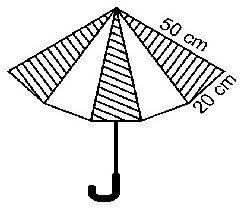
Answer :
First we find the area of one triangular piece.
Here, a = b = 50 cm, c = 20 cm
Now, s = (a + b + c)/2 = (50 + 50 + 20)/2 = 120/2 = 60 cm
Area of one triangular piece = √{s(s – a)(s – b)(s – c)}
= √{60(60 – 50)(60 – 50)(60 – 20)}
= √{60 * 10 * 10 * 40}
= √{6 * 10 * 10 * 10 * 4 * 10}
= 10 * 10 * 2√6
= 200√6 cm2
Area of 10 such triangular pieces = 10 * 200√6 = 2000√6 cm2
Hence, cloth required for each colour = 2000√6/2 = 1000√6 cm2
Question : 7: A kite in the shape of a square with a diagonal 32 cm and an isosceles triangle of base 8 cm and sides 6 cm each is to be made of three different shades as shown in figure. How much paper of each shade has been used in it?
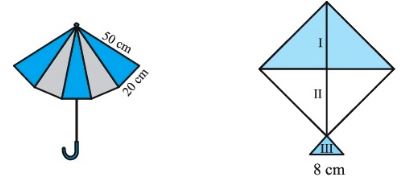
Answer :
ABCD is a square.
So, AO = OC = OB = OD and ∠AOB = 90°
[Diagonals of a square bisect each other at right angles]
Given, BD = 32 cm
⇒ OA = 32/2 cm = 16 cm
∆ABD is a right triangle.

So, area of ∆ABD = 1/2 * base * height
= 1/2 * 32 * 16 =
= 16 * 16
= 256 cm2
Thus, area of ∆BCD = 256 cm2
For triangle CEF, a = b = 6 cm, c = 8 cm.
So, s = (a + b + c)/2 = (6 + 6 + 8)/2 = 20/2 = 10 cm
Now, area of the triangle = √{s(s – a)(s – b)(s – c)}
= √{10(10 – 6)(10 – 6)(10 – 8)}
= √{10 * 4 * 4 * 2}
= √320
= 17.92 cm2
Hence, paper needed for shade I = 256 cm2, for shade II = 256 cm2 and for shade III = 17.92 cm2
Question : 8: A floral design on a floor is made up of 16 tiles which are triangular, the sides of the triangle being 9 cm, 28 cm and 35 cm (see figure). Find the cost of polishing the tiles at the rate of 50 p per cm2.

Answer :
We have lengths of the sides of 1 triangular tile are a = 35 cm, b = 28 cm, c = 9 cm.
So, s = (a + b + c)/2 = (35 + 28 + 9)/2 = 72/2 = 36 cm
Now, area of 1 triangular tile = √{s(s – a)(s – b)(s – c)}
= √{36(36 – 35)(36 – 28)(36 – 9)}
= √{36 * 1 * 8 * 27}
= √7776
= 88.2 cm2
So, area of 16 such tiles = 16 * 88.2 cm2
Cost of polishing 1 cm2 = 50 paise = Re 0.50
Hence, total cost of polishing the floral design = Rs 16 * 88.2 * 0.50 = Rs 705.60
Question : 9: A field is in the shape of a trapezium whose parallel sides are 25 m and 10 m. The non-parallel sides are 14 m and 13 m. Find the area of the field.
Answer :
In the figure ABCD is the field. Draw CF || DA and CG ⊥ AB.
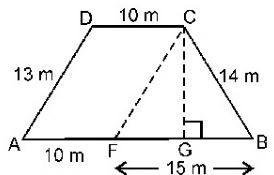
DC = AF = 10 m, AD = FC = 13 m
For ∆BCF, a = 15 m, b = 14 m, c = 13 m
Now s = (a + b + c) = (15 + 14 + 13)/2 = 42/2 = 21 m
∴ Area of ∆BCF = √{s(s – a)(s – b)(s – c)}
= √{21(21 – 15)(21 – 14)(21 – 13)}
= √{21 * 6 * 7 * 8}
= √7056
= 84 m2
Also, area of ∆BCF = 1/2 * base * height
= 1/2 * BF * CG
⇒ 84 = 1/2 * 15 * CG
⇒ CG = (84 * 2)/15
⇒ CG = 168/15
⇒ CG = 11.2 m
Again, area of the trapezium = 1/2 * sum of the parallel sides * distance between them
= 1/2 * (25 + 10) * 11.2
= 35 * 5.6
= 196 m2
Hence, area of the field = 196 m2
